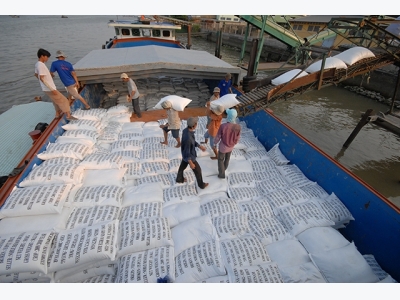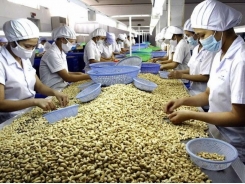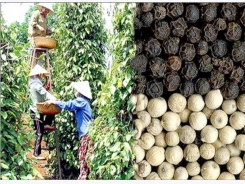Vietnamese rice earns high export in 2017

Farmers in Mekong Delta region harvest rice. Vietnam's rice export recorded a good year in 2017 as export volume reached 6 million tonnes. (Credit: NDO)
Vietnam's rice export recorded a good year in 2017 as export volume reached 6 million tonnes, thanks to an increased demand on the world market.
According to experts, Vietnamese rice has expanded its export market towards high quality. However, in order to achieve the export target of 4.5-5 million tonnes per year during 2017-2020, there is still much work to be done.
According to the Ministry of Agriculture and Rural Development (MARD), last year the country exported about 6 million tonnes of rice, valued at US$2.66 billion, up 22.4% in volume and 23.2% in value over the same period in 2016.
MARD Deputy Minister Ha Cong Tuan affirmed that the result is a great success. In early 2017, experts predicted that the year would be difficult for rice export due to a range of challenges from unresolved issues in the rice markets to the negative effects of climate change on rice production. Therefore, the goal set by the rice sector in 2017 was to export only 5 million tonnes, but by the end of the year the figure increased to nearly 6 million tonnes.
Secretary General of the Vietnam Food Association Huynh Minh Hue said that last year climate change negatively affected rice supply in export countries. Moreover, that Vietnamese rice tends to increase in both quantity and quality facilitates expansion of Vietnamese rice consumption markets with increased export value.
In particular, from 2018, China, one of Vietnam's largest rice importers, reduces import taxes on glutinous rice. If Vietnam could take full advantage of this policy, Vietnamese rice exports would have even more opportunities.
MARD also revealed that to expand the rice export market for Vietnamese enterprises, recently a delegation composed of representatives from various Vietnamese units organised trade promotion for Vietnamese rice in the Ivory Coast as this country is considered as a potential export market.
Together with that, MARD, in collaboration with the Ministry of Industry and Trade and Vietnam’s counselors and businesses in foreign countries, continues seeking export markets for Vietnam agricultural products in general and rice in particular.
Dr Nguyen Do Anh Tuan, Head of the MARDs’ Institute of Policy and Strategy for Agriculture and Rural Development, said that Vietnamese rice exporters still face many challenges, particularly those concerning the compliance with standards on technical barriers and food hygiene and safety from fastidious markets. In addition, the dependence on several key markets also affects the export of Vietnamese rice.
The rice industry has been asked to reorganise production and begin focusing on improving quality. Under the 2017-2020 strategy for rice export market development, Vietnam aims to export from 4.5 to 5 million tonnes of rice per year, earning an average turnover of US$2.2-2.3 billion a year (with glutinous rice accounting for 20%). During 2021-2030, the rice export volume will be reduced to about 4 million tonnes per year but the annual revenue is expected to increase to US$2.3-2.5 billion, focusing on high value rice (glutinous rice accounting for 25%).
The strategy clearly states that by 2020, the Asian market accounts for 60% of Vietnam’s total rice export turnover, while the African market accounts for 22%, the American market 8%, and the European market 5%. The ambitious goal requires the rice sector to do a lot of work targeting to boost production in the direction of applying high technologies and raising productivity and quality, along with building rice export brand and promoting trade and product introduction activities.
Có thể bạn quan tâm
Phần mềm

Phối trộn thức ăn chăn nuôi

Pha dung dịch thủy canh

Định mức cho tôm ăn

Phối trộn phân bón NPK

Xác định tỷ lệ tôm sống

Chuyển đổi đơn vị phân bón

Xác định công suất sục khí

Chuyển đổi đơn vị tôm

Tính diện tích nhà kính

Tính thể tích ao hồ



 Việt Nam achieves record cashew exports
Việt Nam achieves record cashew exports  Agriculture dogged by high cost and low quality
Agriculture dogged by high cost and low quality